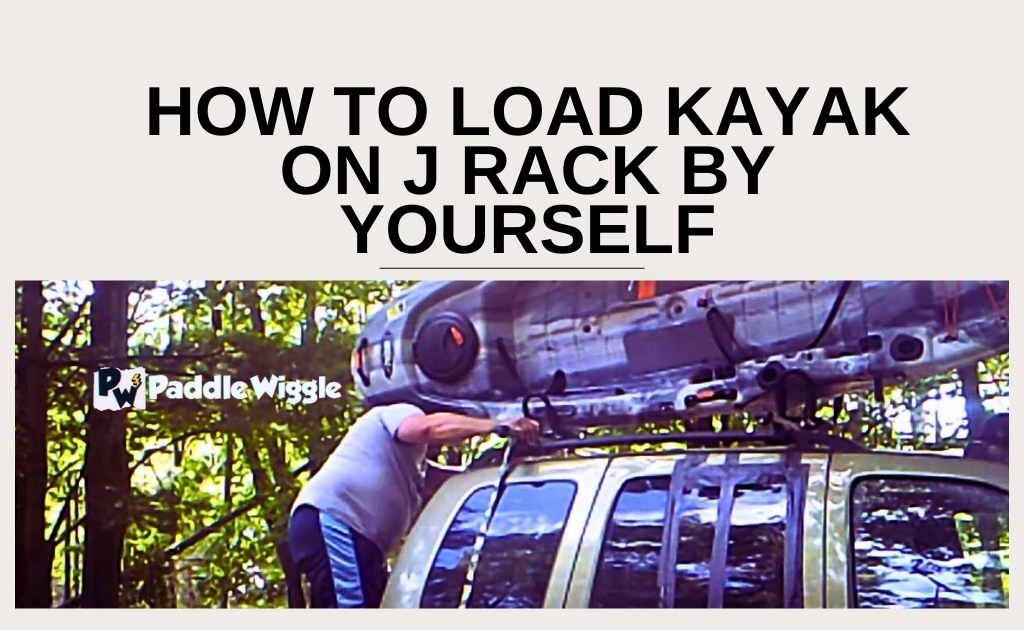For passionate kayaking enthusiasts, finding the best way to transport their beloved kayak is a top priority. One question that often arises is, “How far can a kayak hang out of a truck?” This question holds significant importance, not only for safety reasons but also to ensure compliance with the law.
So, how far can a kayak hang out of a truck? According to the guidelines in section § 658.13, the Federal Highway Administration allows a maximum boat overhang of 3 feet in the front and 4 feet in the rear. Notably, these measurements are excluded from the calculation of the vehicle’s total length.
To avoid potential legal issues and guarantee your safety on the road, it is crucial to secure your kayak within these prescribed limits properly.
This article will explore all you need to know about kayak overhanging on trucks. We’ll also discuss different laws to ensure you have hassle-free kayak transportation.
Also check: Should A Kayak Be Transported Upside Down Or NOT?
Contents
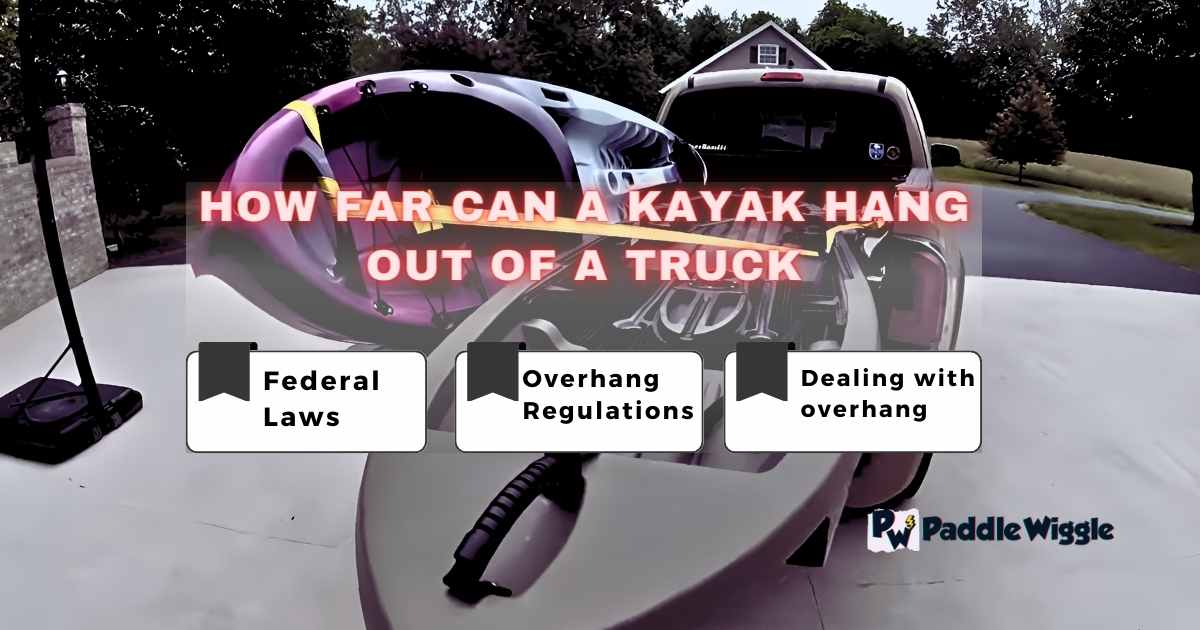

Federal Laws for Kayak Overhang on Trucks
Federal laws governing how far something can stick out of a truck are of utmost importance in promoting road safety and consistency throughout the United States.
Maximum Overhang Limits
The Federal Highway Administration (FHWA) guidelines are found in Title 23 of the Code of Federal Regulations (23 CFR § 658.13). The FHWA’s regulations serve as a reference for states to develop their specific guidelines.
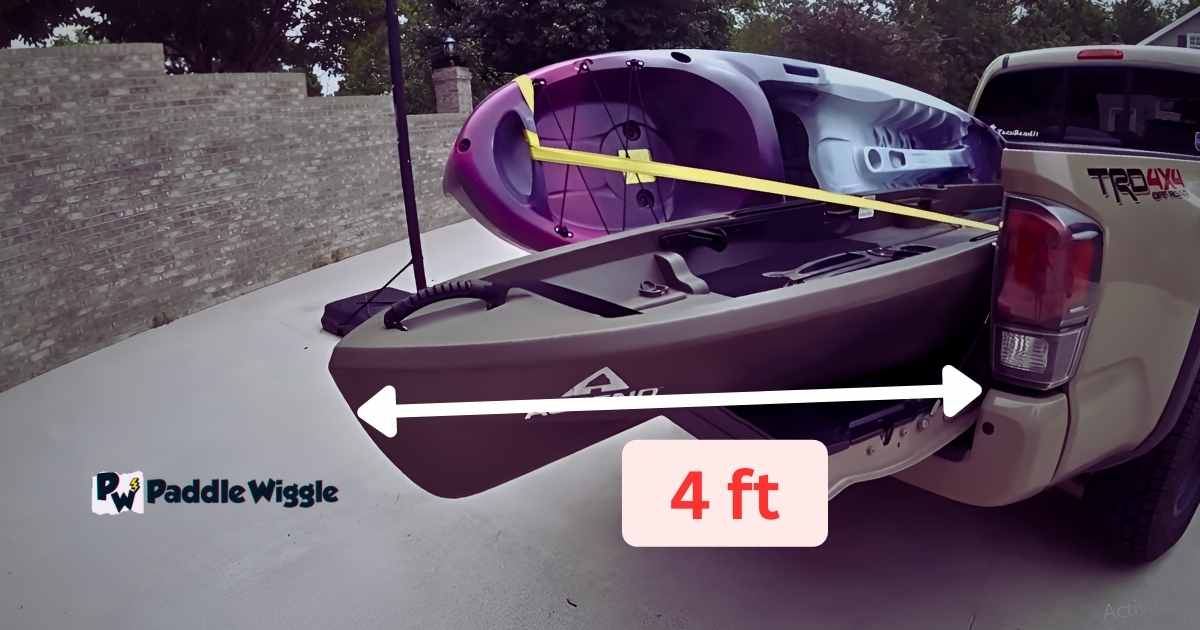

According to the law:
- Front Overhang Limit: The maximum allowable overhang from the front of the truck is generally limited to 3 feet. This means that any load, including a kayak, extending beyond 3 feet from the front bumper may be considered non-compliant with federal laws.
- Rear Overhang Limit: For the rear overhang, the maximum allowance is typically limited to 4 feet. If a kayak or any other load extends more than 4 feet from the rear of the truck, it might violate the federal overhang regulations.
Truck Overhang Regulations in Different States
Understanding the rules for carrying kayaks on trucks can be important in each state. Some states have specific guidelines for kayak overhang, while others follow general rules for transporting cargo.
Let’s take a closer look at the guidelines established by different jurisdictions.
Overhang Regulations In California
There are important rules in California about how much a kayak can hang out from a truck. These rules are there to keep everyone safe and follow the law.
According to Vehicle Code Section 35411, your kayak should not extend beyond the width of your truck’s fenders. If it sticks out too much, you might be breaking the state’s overhang regulations.
Breaking these rules can lead to legal problems and be dangerous for you and others on the road. So, it’s crucial to ensure your kayak is properly secured within the allowed limits for a safe and legal trip.
Overhang Regulations In Texas
Texas has more detailed requirements.
The Texas Transportation Code 621.206 states that without permits, vehicles are not allowed to exceed 4 feet from the rear bumper and 3 feet from the front.
This means that transporting something like a kayak on a truck must not extend more than 4 feet from the back and 3 feet from the front of the truck unless you have special permits.
After you get the permit, you must display a red flag at the end of the extended part.
This flag is a warning to other drivers, so they can see the overhanging object and drive carefully around it. It helps avoid accidents by making the load more visible.
Instead of a red flag at night, you should use a red light to signal the extended load. This serves the same purpose as the flag, making sure other drivers can see the overhang easily, even in the dark.
Overhang Regulations In New York
In New York, the rules for trucks with overhanging loads are similar to those in Texas.
As per New York Vehicle and Traffic Law § 375, you must use safety measures if your vehicle sticks out four feet or more from the front or back. In the daytime, display a red flag, at least twenty-four inches square, on the far end of the extending part.
At night, you need to have a red light at the back and an amber light at the front. This helps others see your vehicle from at least 500 feet away. These measures are in place to keep everyone safe on the road.
Overhang Regulations In Florida
Florida Statute 316.515 aligns with Federal Laws. For most vehicles, like trucks carrying kayaks, the load cannot extend more than 3 feet beyond the front wheels or the front bumper if the vehicle has one.
But, if it’s a special type of vehicle called a stinger-steered automobile transporter, the load can stick out a bit more, but it still can’t go beyond 4 feet from the front bumper.
So, if you’re carrying a kayak on a truck in Florida, make sure it only goes 3 feet from the front wheels or front bumper. And for those special transporters, it should stick out at most 4 feet from the front bumper. Following these rules will keep you safe and within the law while transporting your kayak.
So, How to Overhang a Kayak Legally on a Truck?
Transporting a kayak on a truck can be a convenient way to enjoy your favorite water sport. However, following trailer overhang regulations is essential to ensure your safety and comply with the law. Here’s a more detailed guide on how to legally overhang a kayak on a truck:
Understand the Regulations
Begin by understanding the regulations related to trailer overhang for your specific state and any states you’ll be traveling through. Trailer overhang regulations typically specify the maximum allowable distance that a load, such as a kayak, can extend beyond the rear of the truck. They’re meant to keep the roads safe and prevent accidents.
Measure Your Kayak
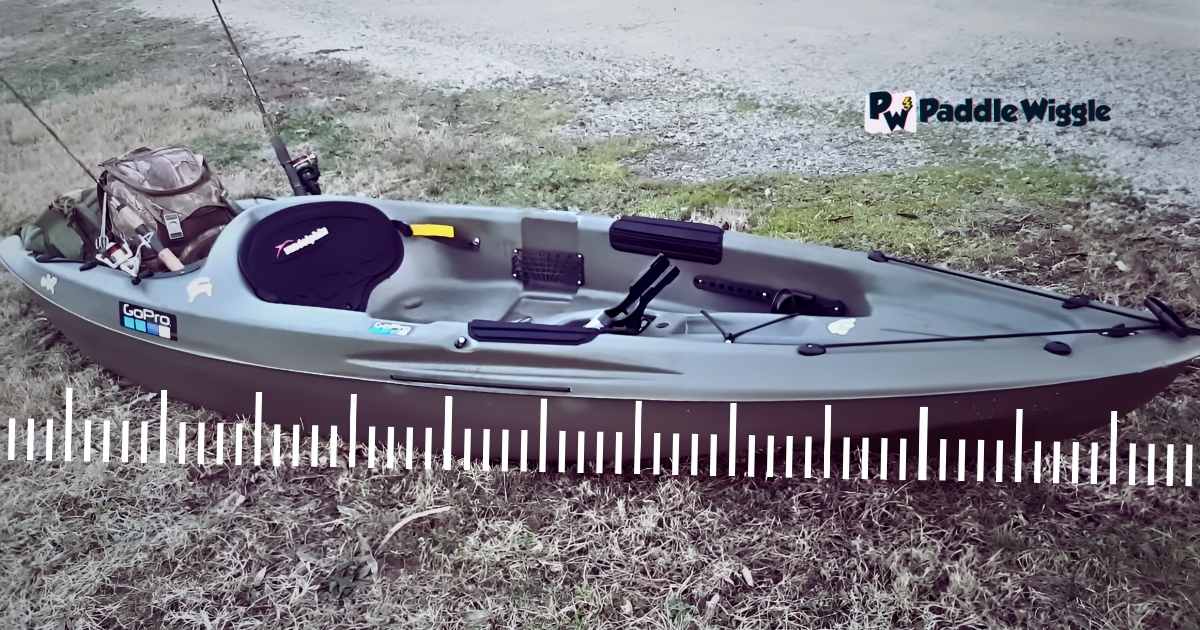

Before loading your kayak onto the truck, measure its length accurately. Knowing the length of your kayak is crucial in determining if it complies with the overhang limits set by the regulations. Ensure that the kayak’s length and any additional equipment do not exceed the allowed overhang limit.
Properly Secure the Kayak
To legally overhang a kayak on a truck, it must be securely fastened to the truck bed. Use reliable tie-down straps to ensure the kayak remains stable during transportation. Ensure the kayak is centered within the truck bed to maintain proper balance and prevent potential shifting during the journey.
Display Required Safety Devices
Suppose your kayak extends beyond the truck’s rear bumper by a certain distance (as specified by regulations). In that case, it is mandatory to use specific safety devices to make the overhang visible to other drivers.
During the day, attach a red flag to the end of the extended portion. At night, use a red light to signal the overhang. These safety measures help warn other drivers of the extended load and reduce the risk of accidents.
Be Mindful of State-Specific Requirements
Trailer overhang regulations may vary from state to state. When planning a trip across different states, research and be aware of each state’s specific overhang requirements. Adhering to state-specific regulations is essential to avoid potential legal issues and ensure a smooth journey.
Drive Responsibly
Driving responsibly and cautiously once your kayak is legally overhanging on the truck. Avoid sudden maneuvers and maintain a safe distance from other vehicles. Stay attentive to road conditions and weather, as these factors can impact the stability of your load during transportation.
Best practices for overhanging a kayak on a truck
Before hitting the road with an overhanging kayak in your truck, it’s essential to familiarize yourself with the local laws and regulations. Some areas may require additional safety measures to ensure visibility and prevent accidents.
Using truck bed extenders for hauling kayaks
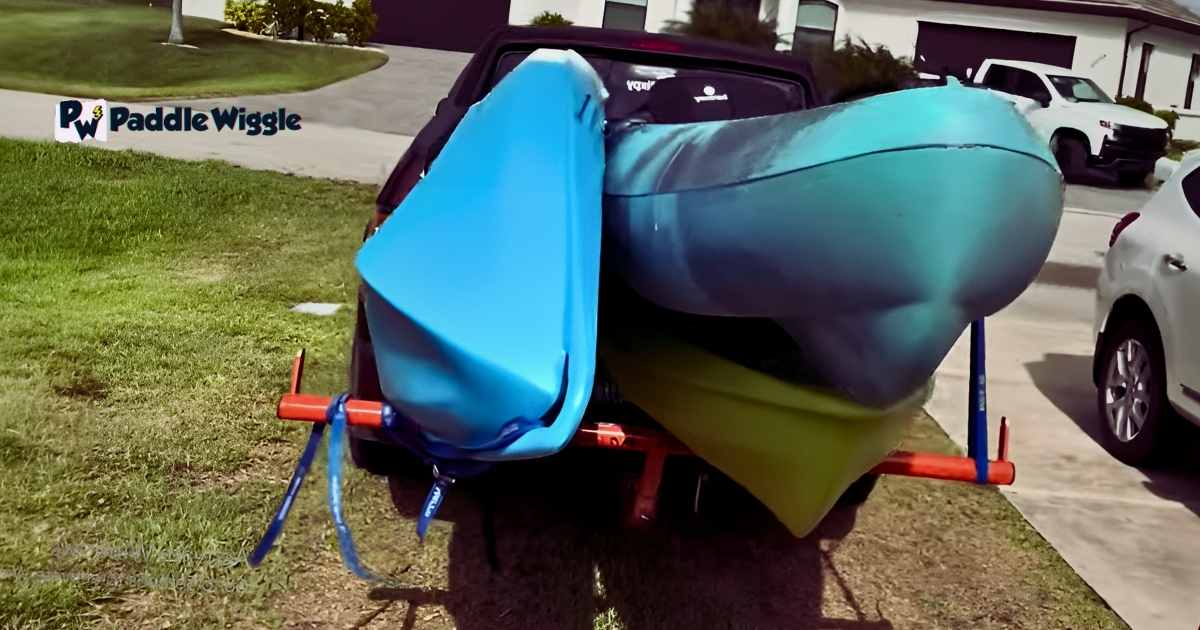

Truck bed extenders are a game-changer. They provide an effective solution for those looking to haul their beloved watercraft safely and securely. By increasing the overall capacity of your truck bed, these extenders allow you to carry longer items, such as kayaks, easily.
There are various options available to suit different needs and preferences. Here are some popular types:
- Tailgate Extenders attach directly to your tailgate, effectively lengthening its reach and providing extra support for longer items like kayaks.
- Hitch-Mounted Extenders: These attach to your vehicle’s hitch receiver, extending the length of your truck bed while keeping it separate from the tailgate.
- Folding Extenders: As the name suggests, these extenders offer flexibility by folding down when not in use, allowing for easy storage and convenience.
Each type has its advantages and considerations, so choose one that best suits your requirements.
Dealing with overhang: what to do if your kayak exceeds limits
If you find that your kayak extends beyond legal limits while transporting it on a truck, there are steps you can take to handle the situation safely and responsibly.
Here’s what you can do:
Seeking Alternative Transportation Methods
If your kayak is too big for the truck and exceeds legal limits, consider these options to transport it legally:
Renting Trailers
Look into renting a specialized kayak trailer designed to transport oversized kayaks securely. These trailers have extended lengths and additional support to ensure safe and legal transportation.
Utilizing Professional Services
You can also seek help from professional transportation services that specialize in moving large items like kayaks. They have the expertise and equipment needed to transport your kayak within legal limits.
Potential Hazards of Overhanging Boats on Trucks During Turns
When a kayak extends beyond the bed of a truck, it creates an overhanging load that can affect the vehicle’s stability and maneuverability. The longer the overhang, the greater the potential for accidents or damage to the kayak.
Several factors come into play when evaluating these risks:
- Centrifugal force: As a truck negotiates a turn, centrifugal force pushes outward from the center of rotation. This force can cause an overhanging kayak to sway or even detach from its securing mechanisms.
- Increased turning radius: With an extended load, trucks require wider turns to avoid hitting curbs, other vehicles, or pedestrians. Failing to account for this increased turning radius can result in collisions or property damage.
- Limited visibility: Overhanging loads obstruct rearview mirrors and may hinder peripheral vision for drivers. This reduced visibility increases the chances of not spotting potential hazards while making turns.
Know How To Navigate turns safely to avoid accidents or damage
To make sure you transport your kayak safely and follow the law, here are some easy tips, especially when you’re turning with an overhanging load like a kayak on a truck:
Secure Your Load (Kayak) Properly
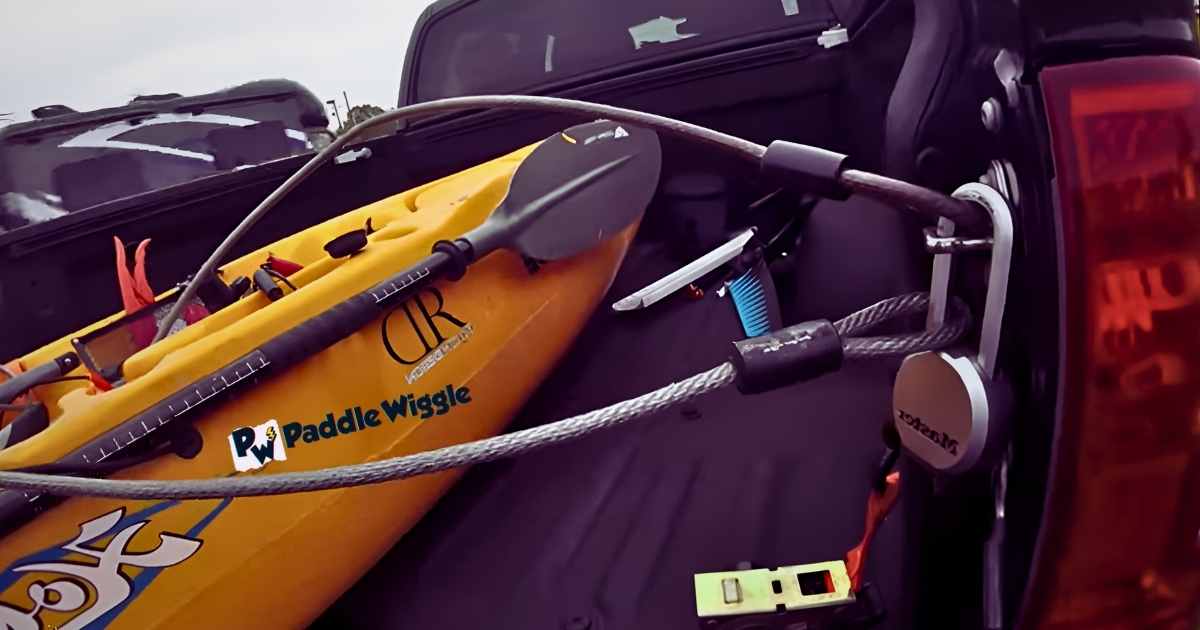

Use the right tie-down straps and supports to fasten your kayak to the truck bed tightly. Check the straps are tight to avoid any shifting or loosening while driving.
Use Warning Flags and Lights
Attach a red flag at each corner of your extended kayak during the day. Use red lights to show other drivers your overhanging load at night or when visibility is low.
Slow Down
Be careful when turning and reduce your speed. Driving slower helps you stay in control of the truck and the extended kayak. It also lets you react quickly to any surprises on the road.
Plan Your Route
Before you start, look at the map and know the way. Find any tricky turns or places where driving might be difficult. You can pick an alternative route if it’s smoother and safer.
Keep a Safe Distance
Leave enough space between your truck and other vehicles, especially when turning. This gives your extended kayak room to move without causing problems or accidents.
5 Tips for Safely and Legally Transporting Your Kayak in a Truck
Transporting your kayak in a truck can be a fantastic way to enjoy water adventures. To ensure both safety and compliance with the law, follow these five essential tips for safely transporting your kayak:
Inspecting the truck bed and tie-down equipment before each trip
Before embarking on your kayaking adventure, it is crucial to inspect both your truck bed and tie-down equipment thoroughly. Start by checking the condition of your truck bed, ensuring there are no sharp edges or protrusions that could potentially damage your kayak during transportation. Look out for any loose bolts or screws that may need tightening.
Next, examine your tie-down equipment, including straps, ropes, and ratchets. Check for signs of wear and tear, such as fraying or stretching. It’s important to replace any damaged equipment promptly to ensure the safety of your kayak during transit.
Using additional safety measures like bow and stern lines to prevent shifting
While securing your kayak with sturdy straps is essential, using additional safety measures can provide extra stability during transport. Consider utilizing bow and stern lines to prevent any unwanted shifting or movement.
Bow lines are attached from the front of the kayak to the front of the truck bed, while stern lines connect from the back of the kayak to the rear of the truck bed. These lines help distribute weight evenly and minimize potential swaying or tipping while driving.
Being aware of speed limits and adjusting driving accordingly
When transporting a kayak in a truck, it’s crucial to be mindful of speed limits and adjust your driving accordingly. Higher speeds can create wind resistance that may affect stability, especially if you have a large kayak hanging out from the back.
To ensure a safe journey, adhere to the speed limits recommended for trucks and trailers. Slow down when approaching curves or turns to maintain control over your vehicle and minimize unnecessary stress on your kayak.
Securing loose items within the truck bed
Before hitting the road with your kayak secured in the truck bed, take a moment to secure any loose items within the bed itself. Loose objects can become projectiles if sudden stops or turns occur, potentially damaging your kayak or causing accidents.
Consider using bungee cords or cargo nets to secure any loose gear, ensuring everything remains safely in place throughout the journey. This extra precaution will help protect both your kayak and other drivers on the road.
Knowing legal restrictions and regulations
To avoid any legal issues while transporting your kayak, it’s essential to familiarize yourself with local laws and regulations. Different regions may have specific guidelines regarding how far a kayak can hang out of a truck bed.
Research the rules in your area to ensure compliance. If necessary, invest in extended truck bed accessories that can provide additional support for longer kayaks while still adhering to legal requirements.
Learn More
Can I Exceed The Recommended Overhang Limits For My Kayak?
It is advisable to stay within the recommended overhang limits for your kayak as it can lead to safety hazards and potential penalties. Always adhere to state and federal regulations for secure transportation.
Are There Any Specific Guidelines For Short-Bed Trucks When Hauling Kayaks?
Yes, short-bed trucks have specific guidelines that should be followed when hauling kayaks. These may include using a truck bed extender or roof rack designed for shorter vehicles.
What Should I Do If My Kayak Exceeds The Recommended Overhang Limits?
If your kayak exceeds the recommended overhang limits, consider alternative transportation methods that comply with legal requirements or explore options like disassembling your kayak if possible.
Final Words
Transporting your kayak in a truck requires careful consideration of safety and legal guidelines. So first, know how far you can hang a kayak out of a truck. Then implement those best practices, and utilize the right equipment. This way, you can ensure a secure journey for both your kayak and other road users.


